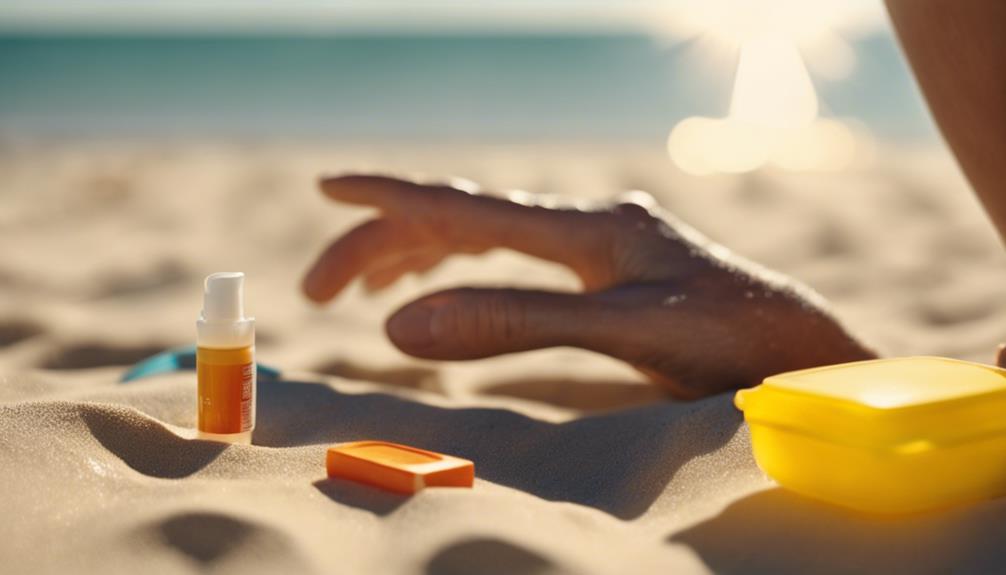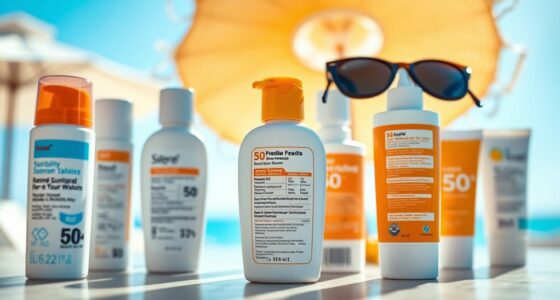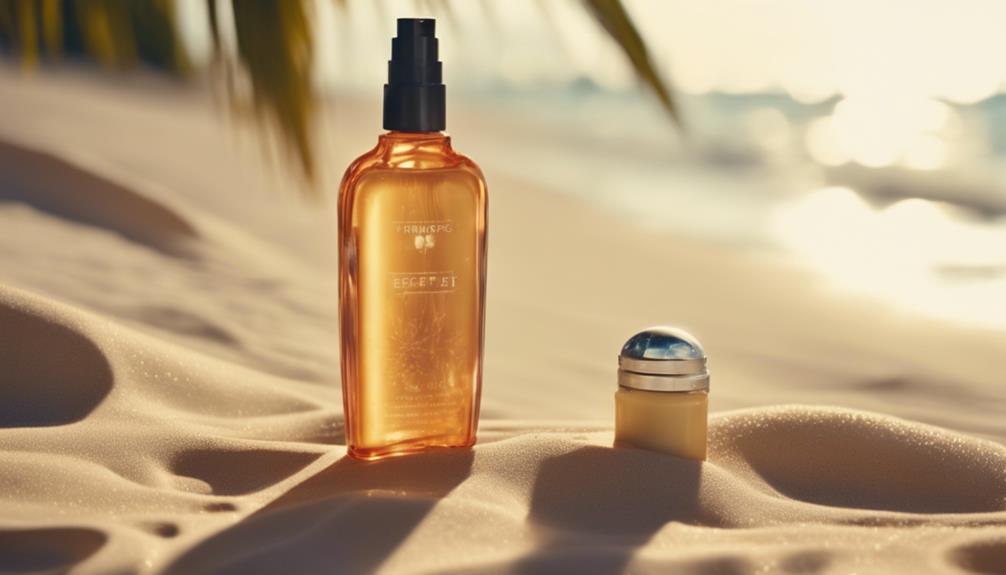The sunscreen mistake 90% of people make is applying too little. You need about 1.5 ounces for your body and one teaspoon for your face. If you don't use enough, you're not getting the protection your skin needs from harmful UV rays. Besides quantity, timing matters too. Apply it 15-30 minutes before going outside for effective absorption. Remember to reapply every two hours, especially if you sweat or swim. Also, don't forget those often overlooked areas like your ears and feet. There's much more to sunscreen safety that'll help keep your skin healthy and protected.
Key Takeaways
- Most people apply too little sunscreen; about 2 ounces is needed for full body coverage.
- Failing to reapply every two hours, especially after swimming or sweating, greatly reduces effectiveness.
- Ignoring expiration dates can lead to using ineffective sunscreen that won't protect against UV rays.
- Applying sunscreen too late, without allowing 15-30 minutes for absorption, limits its protective benefits.
Importance of Proper Sunscreen Application
Applying sunscreen properly is vital to protect your skin from harmful UV rays and prevent sunburn. To guarantee effective UV protection, you need to apply sunscreen generously. The recommended amount is about 1.5 ounces for your body and one teaspoon for your face.
Make sure you're not skimping on coverage; thin layers won't cut it. It's essential to massage the sunscreen thoroughly into your skin for maximum absorption.
Don't forget to apply sunscreen 15-30 minutes before you head outside. This waiting period allows the sunscreen to absorb and maximize its protective qualities. Reapplication is just as important; every two hours, or immediately after sweating, swimming, or towel drying, you should reapply to maintain that UV protection.
It's easy to overlook certain areas, but be sure to cover your ears, feet, and scalp. These spots are often neglected and can lead to painful sunburns.
Common Sunscreen Usage Mistakes

Many people make common sunscreen usage mistakes that greatly reduce their protection against harmful UV rays. It's essential to avoid these pitfalls to guarantee you're fully protected. Here are some common mistakes you might be making:
- Not using enough: You should apply about 2 ounces of sunscreen every time for full body coverage.
- Failing to reapply: Remember to reapply sunscreen every two hours, especially after swimming or sweating.
- Ignoring expiration dates: Check the expiration date; expired sunscreen can lose its effectiveness.
- Applying too late: Apply sunscreen 15-30 minutes before heading outdoors to allow it to absorb and work effectively.
Choosing the Right Sunscreen

Choosing the right sunscreen is vital for guaranteeing your skin gets the protection it needs from harmful UV rays. Start by looking for sunscreen products with a minimum SPF of 30, as this level effectively blocks about 97% of UVB rays.
It's important to opt for broad-spectrum sunscreens that protect against both UVA and UVB rays, providing thorough coverage and reducing your risk of skin cancer.
Pay attention to expiration dates on sunscreen products. Using expired sunscreen can greatly decrease its efficacy, leaving your skin vulnerable to ultraviolet (UV) radiation.
When selecting a formulation, consider your skin type; mineral sunscreens containing zinc oxide or titanium dioxide are often gentler and better suited for sensitive skin.
Don't forget that everyone, regardless of skin tone, needs sunscreen. While darker skin tones have some natural protection due to melanin, it doesn't completely eliminate the risk of skin cancer.
Effective Application Techniques

To effectively protect your skin from harmful UV rays, it's crucial to apply sunscreen properly and consistently. Many people underestimate the importance of effective application techniques. Here are key tips to guarantee you're getting the most out of your sunscreen:
- Use enough: Aim for about 1.5 ounces for full body coverage (that's roughly a shot glass), and one teaspoon for your face.
- Timing matters: Apply sunscreen 15-30 minutes before sun exposure to allow for effective absorption and protection.
- Reapply frequently: Don't forget to reapply every two hours, or immediately after swimming or sweating, to maintain peak protection.
- Massage it in: Apply sunscreen generously and massage it into your skin to guarantee even coverage, especially on often-missed areas like your ears and feet.
Insights From Dermatology Experts

Dermatology experts stress that applying the right amount of sunscreen is essential for effective UV protection. Most people make the common mistake of using insufficient amounts, which leads to inadequate shielding from harmful UV rays. To guarantee full-body coverage, dermatologists recommend applying about 1 ounce, roughly the size of a shot glass.
Consistency is just as important. You should reapply your sunscreen every two hours, especially after sweating or swimming, to maintain its protective benefits. Dermatologists also emphasize choosing a broad-spectrum sunscreen with at least SPF 30 to guard against both UVA and UVB rays effectively.
Education on proper application techniques is critical. Many forget to use sunscreen year-round, even during colder months or overcast days when UV rays are still present. By making sunscreen a daily habit, you can greatly reduce the risk of skin damage and long-term health issues.
Incorporating these expert insights into your routine will help you avoid the pitfalls of sunscreen application and guarantee you're getting the protection you need. Don't let these common mistakes compromise your skin health—be proactive and informed!
Frequently Asked Questions
What Does Gen Z Get Wrong About Sunscreen?
You often underestimate sunscreen's importance, thinking it's only for sunny days. You might also believe darker skin doesn't need it, apply too little, or rely on makeup with SPF without understanding its limitations.
What Is a Commonly Made Mistake When Using Sunscreen?
A commonly made mistake when using sunscreen is applying too little. You should use about 2 ounces for full body coverage and reapply every two hours, especially after swimming or sweating, to guarantee maximum protection.
What Did Gwyneth Paltrow Say About Sunscreen?
Gwyneth Paltrow emphasizes daily sunscreen use, recommending broad-spectrum formulas with at least SPF 30. She believes mineral sunscreens are gentler, and reminds you that UV rays can harm your skin even on cloudy days.
What Percentage of People Reapply Sunscreen?
Think of sunscreen like a lifeguard for your skin—essential yet often overlooked. Only about 30% of people actually reapply it as recommended, leaving many vulnerable to the sun's relentless rays. Don't let yourself be one of them!
How Can I Properly Apply Sunscreen to Avoid Making Mistakes?
Applying sunscreen properly is crucial to avoid the toxic truth about sunscreen. Start with a generous amount and reapply every two hours, or more often if swimming or sweating. Don’t forget overlooked spots like ears, feet, and scalp. Ensure full protection by following these simple steps.
Conclusion
In summary, avoiding the common sunscreen mistake could save your skin!
Did you know that 90% of skin aging is caused by sun exposure? By properly applying sunscreen and choosing the right formula for your skin type, you can greatly reduce your risk of sun damage.
So, don't skip those essential steps—apply generously and reapply often! Your future self will thank you for taking these simple yet effective precautions.
Enjoy the sun safely!









